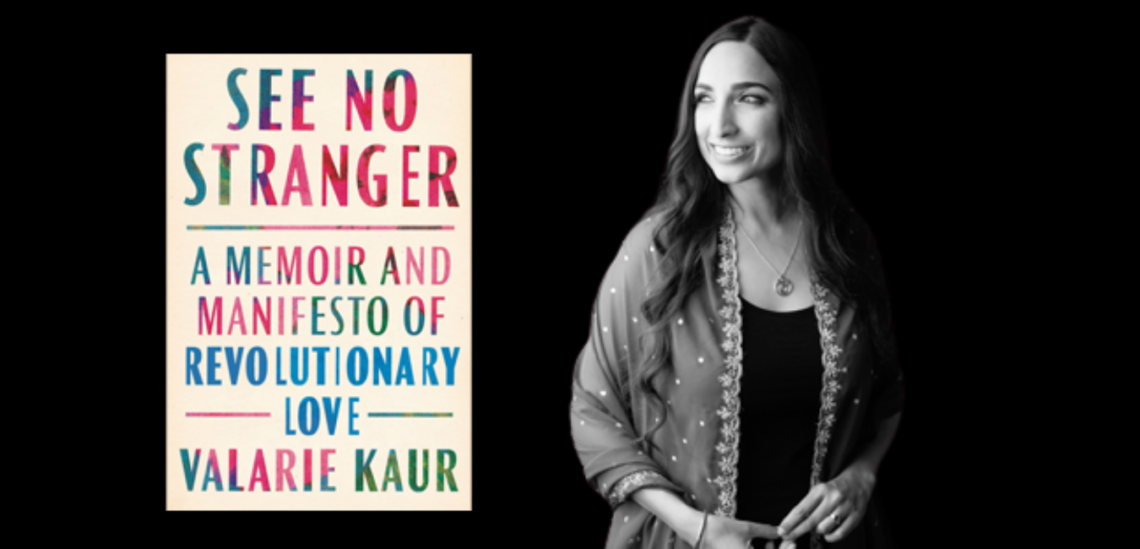By Raj Kaur
Do you feel it? A heaviness, exhaustion, breathlessness, as the world seems to increasing spiral into hate, injustice, and intolerance. Yet within the turmoil and darkness we can also find something else. Glimpses of resiliency and hope, moments where humanity stands hand-in-hand to push forth a better world for all. Valarie Kaur asks us: is this the darkness of the tomb or the darkness of the womb?
In her new book, Valarie Kaur takes us on a remarkable journey starting with her life living on a farm in America and her Sikhi upbringing, to the aftermath of 9/11 including a sharp rise in hate crimes including the murder of Balbir Singh and the Oak Creek Gurdwara massacre. The book speaks to the ongoing sentiments of exclusion, racism, and violence plaguing America and the world at large today.
Within all this, Valarie shares her experiences, both personal and political, and wisdom on how to love others, our opponents, and ourselves: how to perform the sweet labor of love required to bring about change, how to grieve, fight, and re-imagine together in community. Can we do it? With the chaos whirling around us, and so many factions of our world becoming more divided, will we let this continue, or will we dive into the pockets of revolutionary love occurring around us, and forge a better world, together?
My top 3 takeaway from “See No Stranger”
I found an enriching personal connection with Valarie’s book. As soon as I opened the book, I was captivated. Within each page you’ll read about struggle, trauma both personal and collective, and also strength, inspiration, and perseverance. I wasn’t expecting this book to be such a powerful read, and to be taken through a whirlwind of emotions from wonder to hope, from joy to despair, and back again. Reading this book was a transformative experience for me, and below I will highlight my top 3 takeaways from it.
1. What does it mean to ‘see no stranger?’
In the 1500s, Guru Arjan Sahib revealed a shabad (Ang 1299) where he described letting go of his jealousy, how he views no one as his enemy and sees no one as a stranger:
ਕਾਨੜਾ ਮਹਲਾ ੫ ॥
kaanaRaa mahalaa panjavaa || Kaanraa, Fifth Mehla:
ਬਿਸਰਿ ਗਈ ਸਭ ਤਾਤਿ ਪਰਾਈ ॥
bisar giee sabh taat paraiee ||
I have totally forgotten my jealousy of others,
ਜਬ ਤੇ ਸਾਧਸੰਗਤਿ ਮੋਹਿ ਪਾਈ ॥੧॥ ਰਹਾਉ ॥
jab te saadhasa(n)gat moh paiee ||1|| rahaau ||
since I found the Saadh Sangat, the fellowship of Truth seekers. ||1||Pause||
ਨਾ ਕੋ ਬੈਰੀ ਨਹੀ ਬਿਗਾਨਾ ਸਗਲ ਸੰਗਿ ਹਮ ਕਉ ਬਨਿ ਆਈ ॥੧॥
naa ko bairee nahee bigaanaa sagal sa(n)g ham kau ban aaiee ||1||
No one is my enemy, and no one is a stranger. I get along with everyone. ||1||
ਜੋ ਪ੍ਰਭ ਕੀਨੋ ਸੋ ਭਲ ਮਾਨਿਓ ਏਹ ਸੁਮਤਿ ਸਾਧੂ ਤੇ ਪਾਈ ॥੨॥
jo prabh keeno so bhal maanio eh sumat saadhoo te paiee ||2||
Whatever Waheguru does, I accept that as good. This is the sublime wisdom I have obtained from the Holy. ||2||
ਸਭ ਮਹਿ ਰਵਿ ਰਹਿਆ ਪ੍ਰਭੁ ਏਕੈ ਪੇਖਿ ਪੇਖਿ ਨਾਨਕ ਬਿਗਸਾਈ ॥੩॥੮॥
sabh meh rav rahiaa prabh ekai pekh pekh naanak bigasaiee ||3||8||
Ik Onkar is pervading in all. Gazing upon the Divine, beholding Divine, Nanak blossoms forth in happiness. ||3||8||
Valarie explores this notion. As she eloquently explains, to “see no stranger” means to cultivate and embrace a sense of curiosity, of wonder, for all around us. It’s about being present and courageous, and opening the mind to listen to and understand the stories of others. When we allow ourselves to wonder, we become receptive to other perspectives, suspend judgement, and quieten our own internal biases. Here we find the roots of empathy and love. We see the inherent connection between all, each of us a part of the whole.
This type of approach can help strengthen relationships with others, comprehend the plight of those who are suffering, and even help us understand why our opponents act as they do. Through deeper understanding, we begin realizing the root causes of issues – whether in our personal relationships, or society at large – we then become better positioned to develop effective solutions to those issues that perpetuate conflict and inequality. As Valarie explains, “I focus not only on fighting my opponents but reimagining and remaking institutions and cultures that can free all of us.”
I’m reminded of the following beautiful Shabad revealed to Bhagat Kabir on Ang 1367:
ਕਬੀਰ ਹਰਦੀ ਪੀਅਰੀ ਚੂੰਨਾਂ ਊਜਲ ਭਾਇ ॥
kabeer haradhee peearee choo(n)naa(n) uoojal bhai ||
Kabeer, tumeric is yelow, and lime is white.
ਰਾਮ ਸਨੇਹੀ ਤਉ ਮਿਲੈ ਦੋਨਉ ਬਰਨ ਗਵਾਇ ॥੫੬॥
raam sanehee tau milai dhonau baran gavai ||56||
You shall meet the Beloved Divine, only when both colors are lost. ||56||
ਕਬੀਰ ਹਰਦੀ ਪੀਰਤਨੁ ਹਰੈ ਚੂਨ ਚਿਹਨੁ ਨ ਰਹਾਇ ॥
kabeer haradhee peeratan harai choon chihan na rahai ||
Kabeer, tumeric has lost its yellow color, and no trace of lime’s whiteness remains.
ਬਲਿਹਾਰੀ ਇਹ ਪ੍ਰੀਤਿ ਕਉ ਜਿਹ ਜਾਤਿ ਬਰਨੁ ਕੁਲੁ ਜਾਇ ॥੫੭॥
balihaaree ieh preet kau jeh jaat baran kul jai ||57||
I am a sacrifice to this love, by which social class and status, color and ancestry are taken away. ||57||
This Shabad says to me “see no stranger.” I find a connection between the Shabad and Valarie Kaur’s message of revolutionary love. When we perform the sweet labour of love for all, when the “colours” are lost, then the constructs that are used to divide humanity fade away. We see Oneness, we see no stranger.
2. Harnessing the inner Kaur
I admire Valarie for sharing her deeply personal experiences, lessons learned, and wisdom throughout the book. Especially coming from the perspective of a Sikh Punjabi woman, Valarie Kaur offers a voice that other Kaurs can relate with. Representation matters. Valarie speaks of experiences that I could connect with on a level I hadn’t before.
Valarie writes about the complexities faced by Sikh Punjabi women, who often have to fight against both racism and sexism in the world at large, and within their communities. Sikhi stands for equality between all genders. However, Punjabi culture and American culture are riddled with patriarchy that has negative consequences for all genders, within the Punjabi community and beyond. Whether post-9/11 hate crimes against Sikh men, or the Sikh genocide in Punjab, women often have to put their own needs aside to attend to these more urgent crises. The intergenerational trauma lives in all of us, as it does in Blacks and Indigenous peoples, and countless others around the world who have faced decades, if not centuries, of horrific injustice.
However, we also carry the resiliency of our ancestors. Valarie speaks about the importance of solidarity with each other, and importantly, loving ourselves, too.
To truly harness our inner Kaur, not only do we embrace the warrior-sage within and practice revolutionary love towards others, but we must also prioritize taking care of our own bodies, health, and wellness. We must allow ourselves to rest so we do not burn out. It’s okay to take a break. It is not our job alone to save the entire world – we can take a moment to breathe. When we do this, we become more resilient. It allows us to realize that we too are good enough and worthy of the care and love we wish to see blossom in the world. It allows us to recharge so we can be ready to perform the sweet labour of love once more. Valarie Kaur describes her own path towards realizing: “you don’t have to make yourself suffer in order to serve.” Let joy in, wonder about yourself, too. If we want to live in a world that embraces healing, then we must also heal ourselves.
3. How I am practicing revolutionary love
As I was truly inspired by Valarie’s book, I am actively practicing the principles of revolutionary love that Valarie outlines.
One way I am doing this is by wondering about my opponents. I am striving to listen to what they have to say, whether the opponent is someone I had a small conflict with, or a political leader spewing hate. Valarie makes it clear though, that wondering about an opponent does not necessarily mean that you have to feel compassion for the opponent. Instead, when I choose to wonder about that person, it allows me to better understand their position, and that better informs me on how to respond, or how to reimagine a better world. It saves me from falling into the trap of hate.
This does not mean I don’t get angry, disgusted, or upset by what the opponent is saying. Valarie also speaks of the importance of expressing rage in healthy ways. I see this as a way to release that rage, release any feelings of hate, not for the opponent but for myself, to preserve my own inner Kaur, to keep love at the centre of my being.
This process reminds me of the line revealed to Guru Ram Das Sahib (Ang 13), who says to control the vice of khrod (anger), we can break it up into little bits, and only then can we feel love:
ਕਾਮਿ ਕਰੋਧਿ ਨਗਰੁ ਬਹੁ ਭਰਿਆ ਮਿਲਿ ਸਾਧੂ ਖੰਡਲ ਖੰਡਾ ਹੇ ॥
kaam karodh nagar bahu bhariaa mil saadhoo kha(n)ddal kha(n)ddaa he ||
The body-village is filled to overflowing with anger and sexual desire; these were broken into bits when I met with the Holy Saint.
ਪੂਰਬਿ ਲਿਖਤ ਲਿਖੇ ਗੁਰੁ ਪਾਇਆ ਮਨਿ ਹਰਿ ਲਿਵ ਮੰਡਲ ਮੰਡਾ ਹੇ ॥੧॥
poorab likhat likhe gur paiaa man har liv ma(n)ddal ma(n)ddaa he ||1||
By pre-ordained destiny, I have met with the Guru. I have entered into the realm of the Divine’s Love. ||1||
By no means has this been an easy task for me! But it is liberating, and it allows me to strive to be that example that I wish the world to become. I feel a stronger connection to Sikhi too when I harness this outlook.
How will you define the darkness we are in?
Valarie Kaur wrote a remarkable book and provides practical methods and tools to apply the revolutionary love framework to our lives.
Valarie shows us that we can breathe and push. We can perform the sweet labour of love for others, our opponents, and ourselves. There is hope that we can transform and transition this world away from hate, and towards love. I highly recommend Valarie Kaur’s engaging, visionary, and timeless book
You too can practice the principles of wonder and revolutionary love. Whether the darkness you find yourself in right now is personal and intimate to yourself, or its with others around you, or its with the brutalities of the world around us, there is an opportunity for light to be birthed out of this darkness.
About Raj Kaur
Raj K. is passionate about embracing Sikhi, social justice, and nurturing the self and the world around us. After all, we are all infinitely bound in Oneness. Raj K. is an avid writer and promotes wellness, natural living, and reconnection with one’s true roots. Read more at www.wellnatured.ca.





No Comments